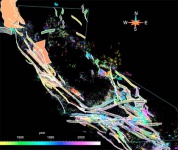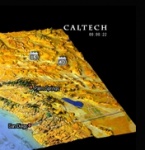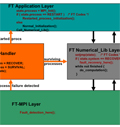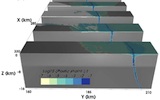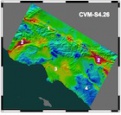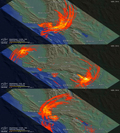Projects
Contents
- 1 Current Projects
- 1.1 Simulating Earthquake Faults (FESD)
- 1.2 GPU Acceleration Project
- 1.3 Supercomputing On Demand: SDSC Supports Event-Driven Science
- 1.4 Petascale Inference in Earthquake System Science (PetaShake-2)
- 1.5 Petascale Cyberfacility for Physics-based Seismic Hazard Analysis (PetaSHA-3)
- 1.6 SCEC M8 Simulation
- 1.7 Blue Waters Project
- 1.8 Fault Tolerance Project
- 1.9 San Andreas Fault Zone Plasticity
- 1.10 CyberShake SGT Calculation
- 1.11 Topology-aware Communication and Scheduling (HECURA-2)
- 1.12 SCEC Data Visualization
- 2 Recent Completions
- 3 High Performance Computing Allocations
- 4 Sources of Funding
Current Projects
Simulating Earthquake Faults (FESD)HPGeoC Researchers are assisting researchers from six other universities and the US Geological Survey (USGS) to develop detailed, large-scale computer simulations of earthquake faults under a new $4.6 million National Science Foundation (NSF) grant announced September 2011. The initial focus is on the North Americn plate boundary and the San Andreas system of Northern and Southern California. |
|
Supercomputing On Demand: SDSC Supports Event-Driven ScienceHPGeoC supports on-demand CalTech users for urgent science earthquake applications. National Science Foundation (NSF) XSEDE supercomputing resource Trestles is allocated to open this new computing paradigm. We've developed novel ways of utilizing this type of allocation as well as scheduling and job handling procedures. |
|
Petascale Cyberfacility for Physics-based Seismic Hazard Analysis (PetaSHA-3)The SCEC PetaSHA-3 project is sponsored by NSF to provide society with better predictions of earthquake hazards. This project will provide the high- performance computing required to achieve the objectives for earthquake source physics and ground motion prediction outlined in the SCEC3 (2007-2012) research plan. |
|
Blue Waters ProjectThis is part of NSF PRAC award. On Blue Waters, our research will investigate how earthquake ruptures produce high frequency ground motions. Â High frequency ground motions are known to have an important impact on seismic hazards. Existing HPC systems cannot achieve the physical scale range needed to explore the source of high frequencies. |
|
San Andreas Fault Zone PlasticityProducing realistic seismograms at high frequencies will require several improvements in anelastic wave propagation engines, including the implementation of nonlinear material behavior. This project supports the development of nonlinear material behavior in both the CPU- and GPU-based wave propagation solvers. Simulations of the ShakeOut earthquake scenario have shown that nonlinearity could reduce the earlier predictions of long period (0 - 0.5 Hz) ground motions in the Los Angeles basin by 30-70. |
|
Topology-aware Communication and Scheduling (HECURA-2)Topology-aware MPI communication, mapping, and scheduling is a new research area. This is to take advantage of the topological path to communication optimization  (either point-to-point or collective). We are participating in a joint project between OSU, TACC and SDSC as a case study in how to implement new topology-aware MPI software at the application level. |
|
Recent Completions
- PetaShake-1 Advanced computational platform designed to support high-resolution simulations of large earthauakes on initial NSF petascale machines, supported by NSF OCI and GEO grant
- HECURA-1 In collaboration with OSU and TACC, we developed non-blocking one-sided and two-sided communication and computation/communication overlap to improve the parallel efficiency of SCEC seismic applications.
- PetaSHA-1/2Cross-disciplinary, multi-institutional collaboration, coordinated by SCEC, each 2-year EAR/IF project with the same name to develop a cyberfacility with a common simulation framework for executing SHA computational pathways
- TeraShake The TeraShake Simulations model the rupture of a 230 kilometer stretch of the San Andreas fault and the consequent 7.7 magnitude earthquake. TeraShake wasa multi-institution collaboration led by SCEC/CME.
- Shakeout The Great California Shakeout is a statewide earthquake drill. It is held in October each year and serves as preparation for what to do before, during, and after an earthquake.
- Parallelization of Regional Spectral Method (RSM)
High Performance Computing Allocations
- NSF XSEDE XRAC Allocations
- DOE INCITE Allocation
- NSF PRAC Blue Waters Allocation
- ANL Early Science Program Allocation
